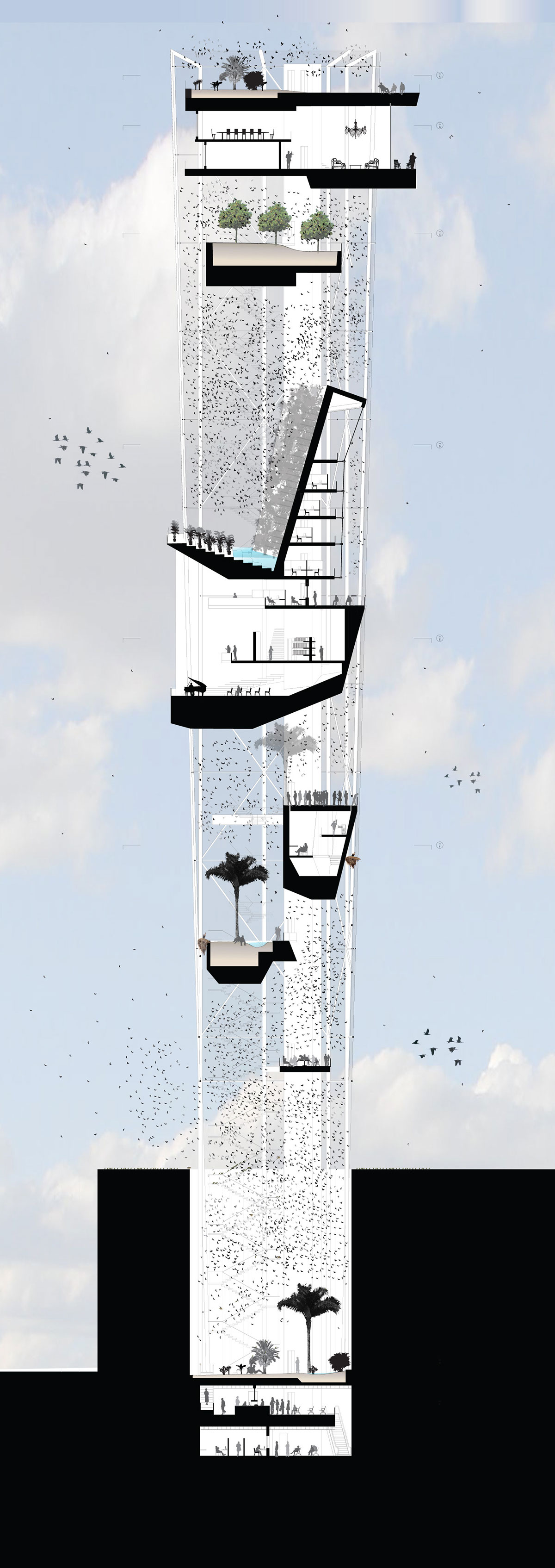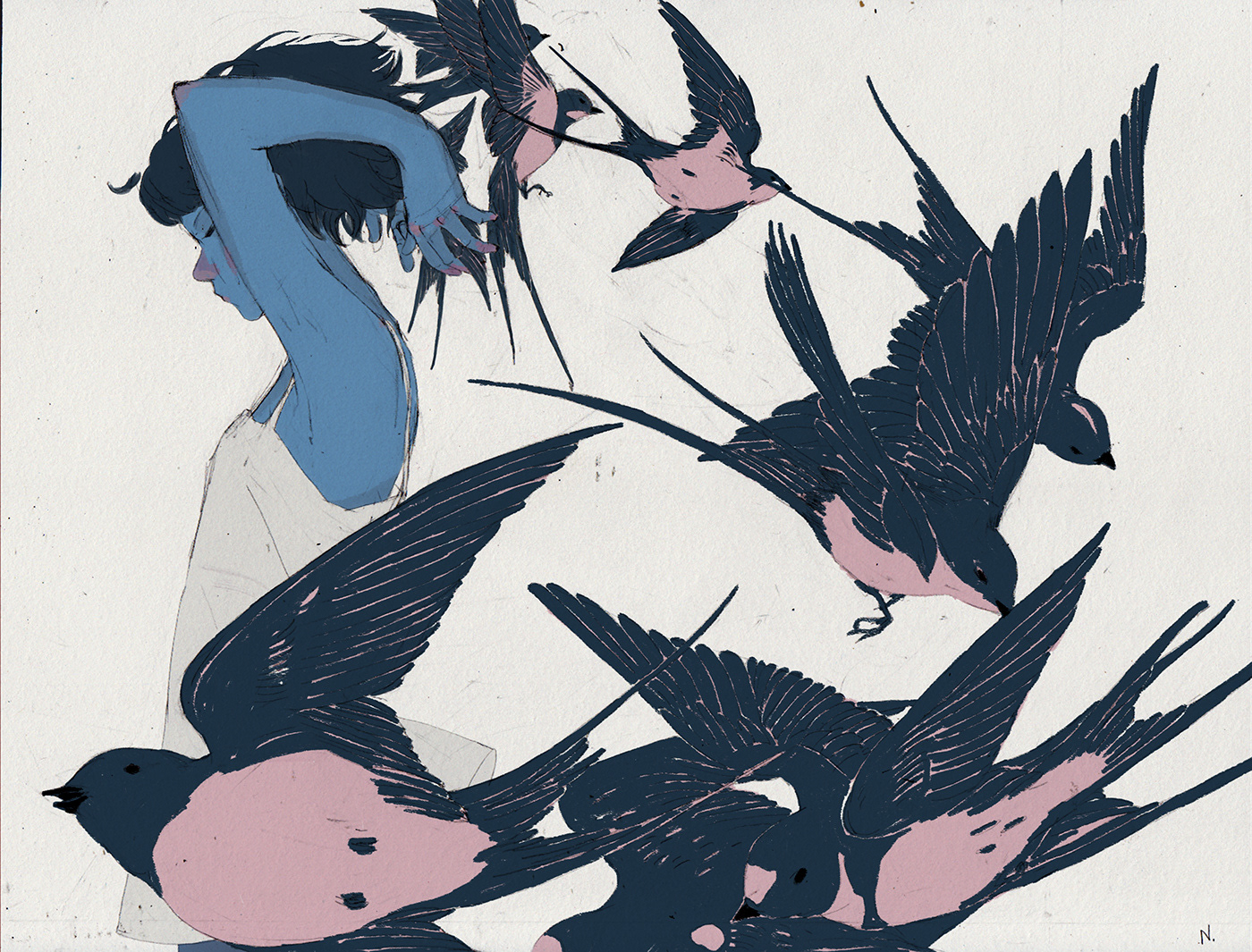The Nest
Experiments in Diplomatic Architecture,
University of Michigan, Taubman School of Architecture, 2012 Thesis
Experiments in Diplomatic Architecture,
University of Michigan, Taubman School of Architecture, 2012 Thesis

Diplomacy is a profession that relies on superior levels of tactful expression. Architecture then can find usefulness in the realm of inter-state relation building as another representational tool for communicating the complexities of the diplomatic message.
The Nest is not meant to poke fun at the embassy as an absurdity in the post-cold war and post-colonial world. Instead it attempts to highlight new ways in which institution building across national boundaries can begin to be an act of building more than just rhetorical bonds and can begin to be the real investment in local community and ecological connections overseas.
This proposal does approach the edge of the ridiculous and the ironic as it lifts out of danger while attempting to return the U.S. foreign service to the dense interior of the city. Its ridiculousness though, is only a response to the reality that the U.S. is spending upwards of 700 million dollars on its facilities in places like Iraq. It is not so far fetched to try and imagine what a $700 million facility might look like if its priorities extended beyond the guarantee of security and began to integrate the other pressing concerns of the various locations that it will become a part of.
My thesis project poses the question of whether architectural innovation can be a catalyst for changes in the diplomatic process itself. How would an architecture, intent on manipulating the way embassy buildings construct relationships with their local communities and environments manifest itself?
Site: Ambiguity and Sensitivities
The construction of a institutional headquarters that will operate within the sovereign territory of another is a process that exaggerates all the prerequisite attention to contextual sensitivities and ideological representation. There are an infinite number of ways that the construction can take place as it is the end result of the inevitable collision of national pride, political attitudes, level of intimacy of state relations, security requirements, local resources as well as foreign, and the local legal and community requirements or requests.
I chose the site of Morocco, as it is simultaneously ambiguous and sensitive as a diplomatic case study. It remains ambiguous because it is outside of the realm of most of the major conflicts that define our current foreign relations conundrums of endless wars, failed states and economic conflict. It remains sensitive as it is predominantly Muslim, a monarchy that continues to restrict human rights, and an example of a country that will be at the forefront of destabilizing environmental disasters like water shortages in the near future. It becomes a fertile ground for redefinition of U.S. diplomacy because it is a Muslim country that attracts an enormous tourist population during the year, it is one of very few Islamic nations that has a good relationship with Isreal, and it was the first nation to recognize the U.S. as an independent nation by offering a property to establish a permanent legation.
The Nest: The Birds
Image and Metaphor
Choosing birds as a subject around which to construct the embassy was opportunistic but extremely useful. There are four imagined scenarios or ideas or histories that emerge because of the presence of the birds that help inform the potential of the "place" of the embassy.
Birds as contextual connector:
Embassy architects are haunted by the necessity to reference local context, be it through local techniques, materials or cultural symbolism. The birds becoming an activator of the embassy allows the building to connect with its connects in a new way. By creating a space for inhabitation by local migrating and nesting wildlife, the diplomatic space becomes truly functionally diplomatic in its ability to provide a space that assists in the protection and promotion of local ecological systems.
Birds as myth:
As a facility that intends to bring people of disparate ideas and value systems together to reach common ends, the bird enters the space between the two cultures as a mediator of each sides imagination of the other. All cultures have their myths about and relationships with birds as an integral part of a building that is so heavily loaded with political meaning the birds may be a way to revive the embassy building typology in the local imagination.
Birds as security:
In this proposal, birds inevitably become intertwined with the security apparatus of the diplomatic premises. A presumption might be that if the birds are precious to the local population, their presence would be a deterrent for terror attacks. This raises the issue of animal rights and human relations to local ecosystems that is becoming more and more sensitive as species continue to succumb to the pressures of climate change and pollution. Having the birds in the apparatus forces us to face the values of the apparatus itself. Is the genuine gesture meant to protect innocent staff not actually something intensely insular and inherently harsh and negative?
Birds as economic producer and historical oppressor:
The difficulty of hosting large populations of birds is the large amount of poop that will accumulate over time and this aside from its annoying or humorous potential relates directly to the dangerous manipulative relationships U.S. diplomacy has had with its national economic goals. In 1856, the U.S. Congress pass the Guano Islands Act. This act, written as a promotion of exploration of supposedly uninhabited islands around the world to facilitate growth in the collection of Guano for fertilizer production, essentially opened the gates for U.S. interests to make imperial moves for economic gain. The birds shit accumulating around the embassy will serve as a reminder of the potential for diplomatic missteps to lead to the exponential accumulation of unpleasantry, but at the same time, the potential collection and use of the guano around the building for local farmers and gardeners may alternatively remind that hard and unpleasant work often leads to unexpected rewards.
In all, my project is a fresh response to the constraints of contemporary contextual situations and wishes to be aspirational about the potential for future projects to challenge the very notion of what architecture can accomplish when it seeks to become a part of cultural, infrastructural, and ecological systems.
The Nest is not meant to poke fun at the embassy as an absurdity in the post-cold war and post-colonial world. Instead it attempts to highlight new ways in which institution building across national boundaries can begin to be an act of building more than just rhetorical bonds and can begin to be the real investment in local community and ecological connections overseas.
This proposal does approach the edge of the ridiculous and the ironic as it lifts out of danger while attempting to return the U.S. foreign service to the dense interior of the city. Its ridiculousness though, is only a response to the reality that the U.S. is spending upwards of 700 million dollars on its facilities in places like Iraq. It is not so far fetched to try and imagine what a $700 million facility might look like if its priorities extended beyond the guarantee of security and began to integrate the other pressing concerns of the various locations that it will become a part of.
My thesis project poses the question of whether architectural innovation can be a catalyst for changes in the diplomatic process itself. How would an architecture, intent on manipulating the way embassy buildings construct relationships with their local communities and environments manifest itself?
Site: Ambiguity and Sensitivities
The construction of a institutional headquarters that will operate within the sovereign territory of another is a process that exaggerates all the prerequisite attention to contextual sensitivities and ideological representation. There are an infinite number of ways that the construction can take place as it is the end result of the inevitable collision of national pride, political attitudes, level of intimacy of state relations, security requirements, local resources as well as foreign, and the local legal and community requirements or requests.
I chose the site of Morocco, as it is simultaneously ambiguous and sensitive as a diplomatic case study. It remains ambiguous because it is outside of the realm of most of the major conflicts that define our current foreign relations conundrums of endless wars, failed states and economic conflict. It remains sensitive as it is predominantly Muslim, a monarchy that continues to restrict human rights, and an example of a country that will be at the forefront of destabilizing environmental disasters like water shortages in the near future. It becomes a fertile ground for redefinition of U.S. diplomacy because it is a Muslim country that attracts an enormous tourist population during the year, it is one of very few Islamic nations that has a good relationship with Isreal, and it was the first nation to recognize the U.S. as an independent nation by offering a property to establish a permanent legation.
The Nest: The Birds
Image and Metaphor
Choosing birds as a subject around which to construct the embassy was opportunistic but extremely useful. There are four imagined scenarios or ideas or histories that emerge because of the presence of the birds that help inform the potential of the "place" of the embassy.
Birds as contextual connector:
Embassy architects are haunted by the necessity to reference local context, be it through local techniques, materials or cultural symbolism. The birds becoming an activator of the embassy allows the building to connect with its connects in a new way. By creating a space for inhabitation by local migrating and nesting wildlife, the diplomatic space becomes truly functionally diplomatic in its ability to provide a space that assists in the protection and promotion of local ecological systems.
Birds as myth:
As a facility that intends to bring people of disparate ideas and value systems together to reach common ends, the bird enters the space between the two cultures as a mediator of each sides imagination of the other. All cultures have their myths about and relationships with birds as an integral part of a building that is so heavily loaded with political meaning the birds may be a way to revive the embassy building typology in the local imagination.
Birds as security:
In this proposal, birds inevitably become intertwined with the security apparatus of the diplomatic premises. A presumption might be that if the birds are precious to the local population, their presence would be a deterrent for terror attacks. This raises the issue of animal rights and human relations to local ecosystems that is becoming more and more sensitive as species continue to succumb to the pressures of climate change and pollution. Having the birds in the apparatus forces us to face the values of the apparatus itself. Is the genuine gesture meant to protect innocent staff not actually something intensely insular and inherently harsh and negative?
Birds as economic producer and historical oppressor:
The difficulty of hosting large populations of birds is the large amount of poop that will accumulate over time and this aside from its annoying or humorous potential relates directly to the dangerous manipulative relationships U.S. diplomacy has had with its national economic goals. In 1856, the U.S. Congress pass the Guano Islands Act. This act, written as a promotion of exploration of supposedly uninhabited islands around the world to facilitate growth in the collection of Guano for fertilizer production, essentially opened the gates for U.S. interests to make imperial moves for economic gain. The birds shit accumulating around the embassy will serve as a reminder of the potential for diplomatic missteps to lead to the exponential accumulation of unpleasantry, but at the same time, the potential collection and use of the guano around the building for local farmers and gardeners may alternatively remind that hard and unpleasant work often leads to unexpected rewards.
In all, my project is a fresh response to the constraints of contemporary contextual situations and wishes to be aspirational about the potential for future projects to challenge the very notion of what architecture can accomplish when it seeks to become a part of cultural, infrastructural, and ecological systems.









